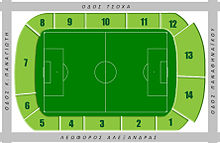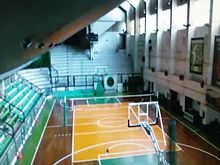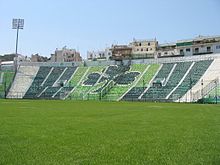Apostolos Nikolaidis Stadium
| Apostolos Nikolaidis Stadium | |
|---|---|
| Leoforos | |

|
|
| Exterior view of the main grandstand | |
| Data | |
| place |
|
| Coordinates | 37 ° 59 '13.9 " N , 23 ° 45' 14.4" E |
| owner | Panathinaikos Athens |
| opening | 1922 |
| Renovations | 2001, 2007, 2013 |
| surface | Natural grass |
| costs | € 7 million (2001 renovation) € 800,000 (2007 renovation) € 2 million (2013 renovation) |
| capacity | 16,620 seats |
| Societies) | |
| Events | |
|
|
The Apostolos Nikolaidis Stadium ( Greek Γήπεδο Απόστολος Νικολαΐδης ) is a pure football stadium in the Greek capital Athens and owned by the Panathinaikos sports club Athens . The stadium bears its name in memory of the athlete Apostolos Nikolaidis , who belonged to the club for years and was later also its president. Since the 2013/14 season, the football team has been playing their games at Leoforos again for financial reasons . The stadium occupies a prominent position in Greek football history and is still home to a large number of Panathinaikos sports departments today.
location
The stadium is located in central Athens in the Ampelokipi district at the foot of Lykavittos on Leoforos Alexandras .
history
On January 19, 1921, Panathinaikos club founder Giorgos Kalafatis was commissioned during a club meeting to find a plot of land on which a new, club-owned stadium should be built. Until then, Panathinaikos football department played and trained on a sports field near the Pedio tou Areos . Three months later, the choice fell on the property in the Athens district of Ambelokipi . This was owned by the city of Athens and was made available to Panathinaikos.
The first construction work began in 1922. In July 1924, following a decision by the Greek Parliament, the Panathinaikos property was overwritten. In 1928 the stadium received its first wooden grandstand. In 1931 the first reinforced concrete grandstand with a capacity of 1,500 spectators was inaugurated, the jacket of which also housed sports facilities for the boxing , gymnastics and fencing departments of the club. In 1933 the covered grandstand was built on today's back straight. In 1936 the stadium underwent extensive renovation measures. With the beginning of the Second World War , the stadium was confiscated by the Greek military in order to be able to use its rooms as a military hospital. After the armed forces took possession of the stadium in 1942 , partisans attacked the building. All damage was only repaired after the end of the war.
In 1948 the stadium was the first in Greece to have floodlights. In the same year, the construction work on the main stand was completed, which from then on offered space for 8,000 spectators. In 1950, construction work began on the west curve. These were completed a year later and increased the stadium's audience capacity to a total of 13,000 seats. In 1949 Panathinaikos began building a swimming pool below the western curve. The east curve was rebuilt in 1955. In 1958 the stadium was the first in Greece to have a turf surface.
In 1984 Panathinaikos finally left the home stadium to move to the then newly built Athens Olympic Stadium . In 2000 the stadium was modernized for € 7 million and Panathinaikos returned to his old home.
In spring 2005, UEFA withdrew the stadium's license to host Champions League games. The reasons for this included the cramped conditions around the stadium and the outdated infrastructure. Since the Apostolos Nikolaidis Stadium is located in one of the most densely populated districts of Athens and the city of Athens categorically ruled out a new building in the same location, Panathinaikos was forced to move back to the Olympic Stadium in the summer of the same year.
The stadium in its current form was originally only supposed to exist until the beginning of the 2010s. Panathinaikos planned to build a new sports complex ( Marfin Stadium ) in the district of Votanikos (2.5 km west of the city center) , which would house all sports departments. The new football stadium should have been completed for this in 2010. For the new land, the Apostolos Nikolaidis Stadium and the property belonging to it were to be returned to the City of Athens and then demolished. A city park was to be built at the same location, which also included a museum for the association. The project also envisaged that the west curve with the famous Gate 13 should be left as a monument.
In 2013, long-running legal disputes related to the construction of the stadium were resolved. The Areopagus decided that the stadium in Votanikos can be built. In particular, the old Apostolos Nikolaidis Stadium does not have to be demolished immediately, but can remain in place until the new arena is completed.
Since Panathinaikos Athens could no longer raise the rent for the Olympic Stadium in the 2013/14 season and also complained that the club had to pay a higher rent than AEK, the club has since played again in the renovated Apostolos Nikolaidis Stadium. The return to the Apostolos Nikolaidis Stadium was also intended to serve as a means of political pressure to push ahead with the construction of their own stadium, since Panathinaikos would have maintained the arena as a tenant as long as it had remained in the Olympic Stadium.
In 2016, new VIP boxes were created in the main stand area above blocks 2 to 4.
Importance of the stadium for Greek sports
After the first grandstand had been erected, all major national and international matches between Greek club teams and the national team took place there over the next 50 years or so.
In addition to the football department of Panathinaikos , AEK Athens , Olympiakos Piraeus , Apollon Athens , Athinaikos Athens and the national team also played their home games at the Apostolos Nikolaidis Stadium at times.
The Apostolos Nikolaidis Stadium hosted the final of the Greek Football Cup 21 times . Only the Athens Olympic Stadium has a higher number with 26 finals.
In the run-up to qualifying for the 2004 European Football Championship , the Greek national coach Otto Rehhagel asked the association to have all home games played at the Apostolos Nikolaidis Stadium. Rehhagel hoped that this measure would give his team a psychological advantage. In contrast to the spacious Olympic Stadium, the spectator stands at the Leoforos are located directly on the edge of the field, so that the spectators can exert significantly higher pressure on the visiting team. Greece won three of four home games in their group 6 and qualified as group winners for the subsequent European championship, which was then won with a 1-0 final victory over Portugal .
The Apostolos Nikolaidis was the site of the first baseball game played on Greek soil . On April 11, 1946, the crews of the USS Missouri and the USS Providence met there .
Coat usage
The first sports hall built in Greece has been located below the east curve (Gate 6-7) since 1959. The hall, which has a capacity of around 1,500 spectators, is currently used as a home for the women's basketball department at Panathinaikos. The men's departments, which used to play their home games in the same place, moved to larger sports arenas due to the small number of spectators. In 2015 the sports hall was renamed Pavlos Giannakopoulos in honor of the long-time president of the basketball department .
In addition to the sports hall, there is also a swimming pool (west curve, gate 13-14), various training halls, changing rooms and a VIP bar (north stand) below the various grandstands . For decades, the stadium was home to almost all sports departments of Greece's largest sports club.
Below the south stand is a Panathinaikos fan shop, which was the first of its kind in Greece.
Statistical
- Record attendance: 29,665 at the game Panathinaikos Athens - FC Bayern Munich (October 18, 1968)
- Current capacity: 16,620 (seats only)
- Between 1931 and 1991 the stadium hosted the final of the Greek Club Cup 21 times .
Web links
Individual evidence
- ↑ Πράσινο φως - Green light in: To Vima from April 11, 2013 , accessed on March 19, 2014 (gr)
- ↑ Article in Ta Nea of May 28, 2013 , accessed on March 19, 2014 (gr)
- ↑ a b Τα υπέρ και τα κατά της επιστροφής του Παναθηναϊκού στη Λεωφόρο. (No longer available online.) Prasinanea.gr, November 6, 2012, archived from the original on May 23, 2014 ; Retrieved March 24, 2014 (Greek). Info: The archive link was inserted automatically and has not yet been checked. Please check the original and archive link according to the instructions and then remove this notice.
- ↑ Panathinaikos back in the Leoforos. Stadionwelt, August 21, 2013, accessed March 7, 2014 .
- ↑ Report on the first baseball game in Greece




